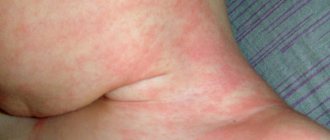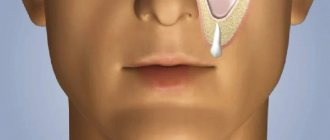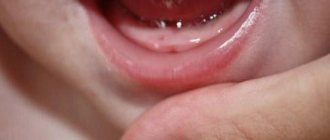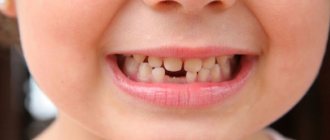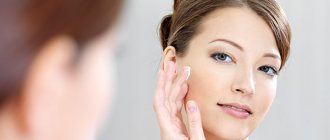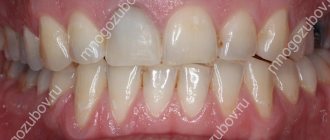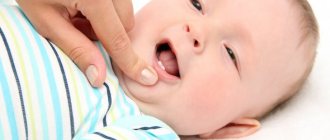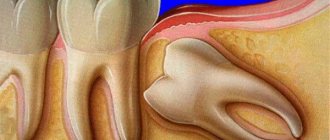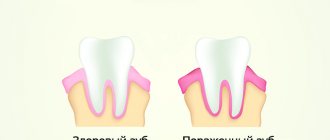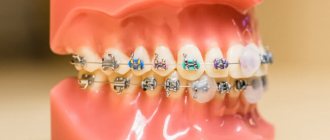Causes of the rash
Due to the fact that the baby is going through a period of adaptation to the environment in his life, rashes on the body are not something supernatural. This is how a very small organism perceives life changes.
Often this phenomenon is due to completely different reasons that have nothing to do with the growth of baby teeth.
The following reasons are probable:
- The body's sensitivity to innovations in nutrition.
- Allergy to household chemicals.
- Excessive salivation as baby teeth grow.
- Genetic predisposition to allergies.
- The influence of external stimuli on a young, fragile organism.
Teething
Skin rashes may appear as a result of exposure to one of the listed factors.
It is very difficult to understand the true cause of irritation and say unambiguously whether it is related to tooth growth or not. Taking into account the true cause of the rash, appropriate therapy is prescribed.
Teething or infectious disease
However, most modern pediatricians agree that such symptoms in an infant as: long-term, over 2-3 days diarrhea, cough, vomiting, fever (increase in body temperature above 38.5 degrees) are most often caused by infection, and not just teething teeth. Therefore, with any of the above symptoms, it is necessary to examine the child by a pediatrician, and only after other causes of increased body temperature have been excluded, efforts should be concentrated on helping the baby to reduce the discomfort from teething.
Rash and teething: how they are connected
It's no secret that during the period of growth of baby teeth, babies become very irritable, as the process is accompanied by severe pain and discomfort. The baby sleeps little, his gums itch, and he cries constantly. Due to severe stress, salivation increases.
The occurrence of a rash is caused by the body's reaction to such a shock. A teething rash, as in the photo below, has a special medical name - “cytokine explosion.”
The appearance of rashes in a baby may be due to a reaction to some unknown product, household chemicals, or clothing. An infection may be to blame. In order to correctly determine the appearance of irritation on the skin, it is necessary to undergo a special medical examination and pass all the necessary tests.
Taking into account the results of the examination, therapeutic tactics are determined.
Early and late teething
Delayed teething is one of the frequent complaints parents bring to their pediatrician or dentist.
In the society of young mothers, a persistent stereotype has been created that a delay in teething in children is a symptom of rickets and similar conditions. But such a statement is not true. Research shows that delayed teething in 93% of cases is associated with pregnancy problems and does not reflect the child’s health status .
After listening to the complaints, the dentist will ask a number of standard questions - and with particular passion will ask about the course of pregnancy and the state of the mother’s health:
- Mother's age. Scientific studies have shown that the mother's age can be associated with certain features of the baby's intrauterine development and even become a predisposing factor for the development of dental diseases.
- Bad habits. Nicotine and other components of tobacco smoke, alcohol abuse are considered as one of the predisposing factors for the development of cleft lip and palate and delay in teething in a newborn baby.
- Errors in nutrition, refusal to take additional multivitamins . From the moment the tooth buds form, which occurs at 5-7 weeks of pregnancy (permanent tooth buds appear in the second trimester of pregnancy), teeth begin to develop and grow, which requires large doses of minerals. It is known that more than 20 minerals are involved in the formation of enamel, but the main ones are calcium, phosphorus, magnesium, potassium, etc. Vitamins are necessary for the complete absorption of minerals and their metabolism.
- Mother's illnesses and the use of certain medications negatively affect the fetus, starting from the 5-7th week of pregnancy; these reasons can be considered as a disruption of the process of differentiation of tooth buds and their subsequent development, which can subsequently affect the timing of eruption and their condition.
- Baby's due date.
- Illnesses of a child during the first 6-12 months of life can have a negative impact on his full growth and development.
- Gender of the child. Studies have shown that the timing of teething differs between boys and girls, and girls develop faster.
The timing of teething is influenced by external factors such as type of feeding, region of residence, and heredity.
Only after analyzing the survey data to assess the baby’s overall development, the doctor will answer whether parents should worry.
In 93% of cases there is no cause for concern, and delayed eruption is normal.
Analyzing data on the timing of teething in modern babies born over the last 10-20 years, one can note a tendency towards an acceleration of the timing. Increasingly, the first tooth appears in the mouth not at 6-7 months, but at 4-5. There are frequent cases of natal and neonatal teeth appearing in newborns.
Video: Interview with a pediatric dentist about teething in children
Localization of rashes
There are likely to be different stages and phasing of the appearance of rashes in a baby as a result of teething. Most often, skin irritation makes itself felt in the neck area. The process then spreads to the limbs, abdomen and other parts of the baby’s body.
The rash on the teeth may be dry, somewhat rough, and accompanied by a strong burning sensation. Often the nature of the occurrence of such a phenomenon affects not only close people around the baby, but also experienced doctors.
It is worth emphasizing once again that this is a peculiar reaction of the body to many provocateurs, each of which requires special attention.
Teething syndrome
Sleepless nights, decreased appetite in children and whims are not the only things moms and dads have to face during this difficult period. Fever, loose stools, and dyspeptic disorders that can appear in children at this age are often attributed to teething.
Such actions are typical not only for parents, but even for some doctors, especially the “old school”. But there is no scientific evidence of the connection between dyspeptic disorders and teething (according to Persin L.S., Elizarova V.M.).
Hyperthermia (high temperature) is a protective reaction of the body that occurs in response to inflammation. If we consider the process of teeth emergence, we can indeed find its signs. The tooth literally tears the mucous membrane from the inside, which provokes local inflammation. But his reaction is so weak that there cannot be high numbers on the thermometer. Only low-grade fever can be attributed to teething - up to 38º C, lasting no more than 2 days. Otherwise, you need to look for another reason.
Nausea, vomiting and diarrhea, and even with fever, are symptoms of an intestinal infection. Considering the child’s desire to put everything in his mouth in order to scratch his gums, this is more than relevant.
Whims, loss of appetite, sleepless nights and low-grade fever can indeed be associated with the appearance of teeth. There is only one reason: constant and persistent itching and burning in the gums.
Video: First teeth
Rashes on the body
Most often, a rash on a child’s teeth appears on the most visible areas - the neck and face.
A similar phenomenon occurs in many places. It may be difficult to see and roughness may form on the baby’s skin. This phenomenon can be due to many reasons:
- baby's reaction to stressful stimuli . This period in a child’s life is very difficult and simply cannot be completely painless. At the same time, the load on the psyche increases significantly;
- Another serious cause of this phenomenon may be a lack of calcium. This is due to the simultaneous eruption of several teeth, which implies the need for an increased dose of calcium. The lack of this component is reflected in skin rashes.
Skin reactions should never be ignored. At the time of occurrence, you should not buy new clothes for your baby; all things, household chemicals and household items should be hypoallergenic. You should also not forget about nutrition; be sure to adjust your child’s diet.
Signs on the face
Most often, a rash on a child’s teeth makes itself felt in the most visible areas – the neck and face. Folk remedies usually do not help with such phenomena, since self-diagnosis by parents, grandmothers and other family members cannot be correct. This requires a professional approach.
It is worth noting that the use of various ointments in infants for other purposes does not usually end well , but only entails a number of unpleasant consequences. It makes sense to undergo a full examination in order to establish the correct diagnosis.
A characteristic phenomenon often occurs due to banal non-compliance with hygienic principles by the baby’s parents. This is especially evident when using low-quality household chemicals . That is why cosmetics, detergents and laundry detergents for babies should be selected very carefully.
During the period of growth of baby teeth, a baby's immunity weakens due to severe stress, which results in rashes on the face.
Burning and rash on the neck
If a rash appears, it is recommended to give your child herbal baths.
It is worth noting that rashes do not appear on their own. Usually, symptoms during teething occur all in a heap: irritability, intense salivation, fever. In this situation, herbal baths are very effective.
It is useful to take baths with celandine, chamomile and other anti-inflammatory plants . After the bathing procedure, it is advisable to lubricate the baby’s body with healing ointments. In this situation, good old baby cream often saves the day. You can use special creams containing panthenol.
Aerial procedures have a special effect. With severe burning, even the use of soft clothing has a strong irritating effect. Air baths provide effective treatment for skin rashes.
How to speed up the process
Often, adults look forward to teething, but there are still no symptoms. What to do in this situation? Until the tooth grows completely, the process is accompanied by many difficulties. The very first obstacle is the bone and crown. After this, the tooth also overcomes the mucous part, which is quite difficult, because this tissue is quite elastic.
To stimulate the teething process, the baby’s saliva contains special components that straighten the mucous membrane and promote the rupture and birth of the tooth. In addition, baby saliva is an antibacterial liquid that helps fight infection, which often occurs as a result of tooth growth.
Adults should take note of the fact that it is impossible to speed up the natural process of tooth growth. This is not at all practical or relevant. No drugs will help.
All products containing calcium will be excreted from the body and absorbed only in small quantities. Moreover, a lack of calcium has nothing to do with it. Medicine does not yet know a clear answer to the question of what exactly causes teething.
The main theory is the formation of the root of the baby tooth , which stimulates the movement of the latter. Of course, growth requires nutrients, but it also takes time for cells to divide.
Teethers help ease your baby's teething condition.
Particularly brave parents decide to undertake the absurd procedure of cutting gums on their own. Such measures are unacceptable. First of all, you will cause severe pain and injure the tissues of the tooth that has not yet sprouted, and also cause an infection.
Such manipulation is done only in dental offices and is used only to stimulate the growth of figure eights.
To alleviate the baby's condition by speeding up the teething process, he needs to be given special teethers. All hard and tough products are suitable for this purpose. Never give your baby a sugar cube . This is a grave mistake that many grandmothers make.
Teething in children: modern concepts
The eruption of baby teeth in children is a routine process that no individual can avoid. This process is determined by both genetic and environmental factors. Theoretically, innervation-induced pressure in the apical part of the teeth induces the process of eruption, which requires long-term adaptation from the periodontal membrane, as well as active movement of the crown follicle, which destroys the overlying bone tissue.
For many years, discussions have continued among representatives of pediatric specialties regarding teething and its impact on the health of infants [1–3]. Therefore, it was even proposed to consider the so-called “teething syndrome in infants,” which has a corresponding reflection in the International Classification of Diseases, 10th revision - ICD-10 (code K00.7) [2]. Apparently, in the coming years it will find its place in ICD-11.
The opinion of the medical community on the issue of the use of special gels that alleviate the main symptoms that often accompany teething, which will be discussed below, seems equally ambiguous.
The appearance of teeth: just the facts
The formation of teeth occurs approximately on the 40th day of embryonic life. The eruption of primary teeth most often occurs in the second half of the first year of life, usually at the age of 6–8 months.
The order of teething in the first year of life is as follows:
- lower middle incisors;
- upper middle incisors;
- upper lateral incisors;
- lower lateral incisors.
In the latest (20th) edition of the Nelson Textbook of Pediatrics, N. Tinanoff (2016) provides the following information about baby teeth:
- lower middle incisors: first signs of calcification (SCC) - 4.5 months of intrauterine development, crown formation (FC) - 4 months, eruption (E) - 6.5 months;
- upper middle incisors: PPK - 3–4 months of intrauterine development, FC - 4 months, P - 7.5 months;
- upper lateral incisors: PPK - 4.5 months of intrauterine development, FC - 5 months, P - 8 months;
- lower lateral incisors: PPK - 4.5 months of intrauterine development, FC - 4¼ months, P - 7 months;
- lower canines: PPK - 5 months of intrauterine development, FC - 9 months, P - 16–20 months;
- upper canines: PPK - 5.5 months of intrauterine development, FC - 9 months, P - 16–20 months;
- first upper molar: PPK - 5 months of intrauterine development, FC - 6 months, P - 12–16 months;
- first lower molar: PPK - 5 months of intrauterine development, FC - 6 months, P - 12–16 months;
- second upper molar: PPK - 6 months of intrauterine development, FC - 10-12 months, P - 20-30 months;
- second lower molar: PPK - 6 months of intrauterine development, FC - 10-12 months, P - 20-30 months [1].
It is quite natural that the timing and order of teething may differ significantly from those given above (the individual characteristics of this process are often genetically determined). To a certain extent, the timing of teething depends on the gender of the child; in girls it usually occurs somewhat earlier and faster.
According to the proposal of A.F. Tour, to calculate the number of baby teeth that a child aged 6–24 months should have, it is necessary to subtract the number 4 from the number of months of life (actual calendar age) [4].
Currently, it is believed that in the process of teething, it is not so much direct perforation of the gum mucosa by crowns that occurs, but rather an increased production of certain hormones in the child’s body, which cause cell death in the gums, freeing up space for teeth.
The review work by I. Kjær (2014) outlines modern ideas about the mechanisms of the process of primary teething in children, and also presents the author’s own hypothesis, according to which the described physiological process depends on three main factors:
- free space in the path of teething;
- lift or pressure from below;
- adaptability (adaptability) of teeth in the periodental membrane [5].
In general, among the many theories and hypotheses (there are about 500 in total) explaining the mechanisms of teething, only four deserve attention: 1) growth of the tooth root; 2) increased hydrostatic pressure in the periapical zone or dental pulp; 3) reconstruction of bone tissue; 4) periodontal traction [6].
In the Russian Federation, explanations for the mechanisms of teething are usually found in the theories of John Hunter (“root” theory), G. V. Yasvoin (“rocket” theory) and A. Ya. Katz (the theory of pressure of a growing tooth on the side walls of the alveoli), as well as I. G. Lukomsky (theory of simultaneous development of tooth and alveolar bone), which readers can familiarize themselves with if they wish.
The crown follicle destroys the overlying bone tissue and thus provides the necessary space along the teething route. This process depends on the state of the ectoderm in the tooth follicle.
The root shield acts as a glandular membrane, the innervation of which creates excess pressure that forces the teeth towards the surface of the shield, periodontal membrane and pulp tissue. As a result of this pressure, the teeth rise in the direction of eruption.
Problematic teething
On the one hand, many pediatricians believe that the teething process does not cause fever or diarrhea. On the other hand, tens to hundreds of articles report hypothermia accompanying teething, bowel disorders and many other symptoms accompanying this physiological process. In general, the medical community recognizes that teething can be accompanied by pain and increased body temperature (hyperthermia) [1].
The so-called “difficult teething” (dentitio difficilis) may be accompanied by local symptoms (swelling/redness/itching of the gums), general malaise, loss of appetite, hypersalivation, rhinorrhea, restlessness and irritability, nausea, regurgitation/vomiting, sleep disturbances, increased body temperature , dyspeptic symptoms, skin rashes, delay or slowdown in weight gain, etc. [7–10].
As indicated by A.L. Zaplatnikov et al. (2018), a key role in the development of various teething symptoms belongs to pro-inflammatory cytokines (in the gingival fluid during primary teething, the concentration of interleukin-1, interleukin-2 and interleukin-8, as well as tumor necrosis factor α, increases) [2].
The presence of symptoms such as hyperthermia, sialorrhea/hypersalivation, sleep disturbances and irritability in children during the first years of life during teething is confirmed by the work of M. Memarpour et al. (2015), S. Massignan et al. (2016), and M. A. Nemezio et al. (2017), and the last two publications used tools and approaches of evidence-based medicine - a systematic review and meta-analysis [11–13].
Since it has been repeatedly demonstrated over the years that the eruption of primary teeth can be problematic and accompanied by pathological manifestations, there is no doubt about the need to treat these symptoms. For this purpose, paracetamol and ibuprofen (oral or rectal dosage forms), some systemic homeopathic remedies (Viburkol, etc.), as well as special children's gels for gums during teething can be used [14–17].
The most convenient to use are topical gels, which are widely used in many countries around the world.
Teething Gels: Possible Ingredients
Currently, about a dozen products for this purpose are simultaneously presented in the pharmacy network of the Russian Federation. If we try to symbolically classify all the currently available gels for gums during teething, then they can be conditionally classified into one of three categories:
1) synthetic gels (with analgesics/anaesthetics); 2) gels based on natural plant extracts; 3) combined gels: synthetic anesthetics combined with natural plant extracts.
The anesthetics in the described gels are most often lidocaine, benzocaine and/or choline salicylate.
Among the antiseptic ingredients of the gels are cetylpyridinium chloride and cetalkonium chloride.
Other components that may be used are polidocanol (a non-ionic detergent) and trometamol (an anti-acidemic agent); these pharmacological agents provide a predominantly local cooling effect when applied to the child's gums.
Dangerous components of teething gum gels
In 2011, the US Food and Drug Administration (FDA) called for the avoidance of any benzocaine-containing products to treat teething symptoms. This recommendation is based on the risk of developing methemoglobinemia in children under the influence of the described anesthetic. Methemoglobinemia is a rare but very serious condition that can sometimes be fatal.
EJ Ip et al. (2018) asked two hundred pharmacists working in 115 pharmacies in the San Francisco Bay Area (USA) to complete a 16-item questionnaire. The majority of respondents (63.0%) were still inclined to recommend benzocaine-containing gum gels for teething infants [18]. Pediatricians have known about the possibility of acute and chronic intoxication with salicylates contained in teething gum gels for more than forty years.
In 2014, the FDA did not recommend the use of lidocaine in teething gels for children. An overdose of lidocaine rubbed into the gums, or if a child swallows too much of it, may cause seizures, severe brain damage, or cardiovascular problems. There are also cases of accidental poisoning of children with lidocaine during its topical use, sometimes with a fatal outcome.
As it turned out, the use of teething gels is accompanied by a potential risk of developing intoxication due to the content of salicylates in them. This, in particular, is reported in the publications of GD Williams et al. (2011), as well as in the latest works of T. Nguyen et al. (2018) and K. E. Hofer et al. (2018) [19–21].
Since 2014 in the UK, the use of oral gels containing salicylates is not recommended for patients under the age of 16 years, which completely excludes such indications for their use as teething in infants. T. K. Oman et al. (2008) demonstrated a case of the development of Reye's syndrome in a 20-month-old child after using a teething gel with choline salicylate [22]. It is believed that this particular case served as the basis for the corresponding recommendations of the British Commission on Human Medicines (CHM). Although representatives of the Medicines and Healthcare Products Regulatory Agency (MHRA) are inclined to believe that the described case is more consistent not with Reye's syndrome, but with acute salicylate poisoning, the recommendation is not to use oral topical gels with salicylic salts acid is retained.
Due to the fact that all anesthetics without exception (benzocaine, lidocaine, salicylates) included in anesthetic gels can pose a danger to the health and life of children, preference should be given to those topical products that do not contain the components listed above, but natural extracts medicinal plants. A similar point of view is shared by T. V. Kazyukova et al. (2015), I. A. Khoshchevskaya (2013), M. G. Lukashevich (2016), E. I. Kleschenko et al. (2017), as well as E. A. Goreva et al. (2017) [7, 9, 10, 23, 24]. M. G. Shchegoleva writes about the preference of protective gels for gums during teething (2015) [25].
Protective gels versus anesthetic gels
One of the newest concepts in recent years is the use of gum gels during teething, which create a protective film at the site of application and do not contain sugar or parabens. Thus, quite recently S. Rosu et al. (2018) presented the results of a pilot randomized trial (open and controlled) carried out by representatives of a number of Romanian and Italian medical institutions. In the study described, a protective gel for gums was used [26].
This gel was used in 27 children (age 3–36 months) for 7 consecutive days; The FLACC system (Face, Legs, Activity, Cry and Consolability Pain Assessment Tool) was used to assess pain. The presence of teething was determined by at least three signs: local pain, swelling, erythema, hypersalivation and deep characteristics of unerupted teeth. Primary symptoms were assessed at baseline and then on days 3 and 7. In addition, the patients' parents recorded daily changes in crying, oral spasms, salivation, local tenderness, swelling and hyperemia of the gums in the charts. The comparison group consisted of 30 children of the same age, in whose treatment a standard industrial gel was used (containing lidocaine, lauromacrogol 600 and chamomile extract); The same research methods were used as in the main observation group [26].
The results of the study made it possible to demonstrate in children of the main group a significant reduction in the severity of pain and swelling of the gums (from the first to the seventh day, p = 0.034), hyperemia (from the first to the third day - p = 0.045, and from the first to the seventh day - p < 0.001 ), which was confirmed by the records of the patients' parents. When assessing the sum of indicators using the FLACC system, the differences between the observation groups were p < 0.005 (in favor of the main group) [26].
As one of the new representatives of protective gels based on natural ingredients available in Russia, one should consider Dentinale® natura, which is an over-the-counter product. Children's gel for gums during teething Dentinal Nature contains the following herbal ingredients:
- natural extract of boswellia/frankincense tree resin (Boswellia serrata);
- natural extract of chamomile (Chamomilla recutita);
- natural extract of aloe/agagae leaf juice (Aloe barbadensis);
- natural extract of saffron (Crocus sativus);
- Sweet orange peel oil (Citrus aurantium dulcis).
All of these components have a pronounced anti-inflammatory, antiseptic and regenerating effect when the described gel is applied to the gums [27]. Boswellia, in addition to the properties described above, also has analgesic properties [28].
Dentinale nature gel, when applied to the gums, forms a protective film, thereby reducing hypersensitivity, inflammation and irritation of the gums (without the use of analgesics). Additional positive characteristics of the product are the absence of sugar and parabens (esters of parabenzoic acid) in its composition.
Apparently, it should be considered that protective gels based on natural plant extracts (Dentinale Natura, etc.) are not just a full-fledged alternative to products for a similar purpose containing lidocaine, benzocaine and/or salicylates, but are significantly superior to them. Protective gels based on natural plant extracts have better tolerability and, most importantly, a better safety profile, and there are no restrictions on their use.
Literature
- Nelson textbook of pediatrics. Kliegman RM, Stanton BF, St Geme III JW et al., eds. 20th ed. Philadelphia. Elsevier, 2016. 3474.
- Zaplatnikov A.L., Kasyanova A.N., Maykova I.D. Teething syndrome in infants: a new look at an old problem // RMJ. 2018; 5 (II): 68–71.
- Sood S., Sood M. Teething: myths and facts // J. Clin. Pediatr. Dent. 2010; 35(1):9–13.
- Tur A. F. Propaedeutics of childhood diseases. 5th edition. L.: Medicine, 1967. 492 p.
- Kjær I. Mechanism of human tooth eruption: review article including a new theory for future studies on the eruption process // Scientifica (Cairo). 2014; 2014: 341905.
- Pediatric therapeutic dentistry. National leadership / Ed. Leontyeva V.K., Kiselnikova L.P.M.: GEOTAR-Media, 2010. 896 p.
- Kazyukova T.V., Radtsig E.Yu., Pankratov I.V. Symptoms of the eruption of primary teeth and possible ways of pharmacological action // RMJ. 2015; 22: 1342–1344.
- Zakharova I. N., Kholodova I. N., Dmitrieva Yu. A., Morozova N. V., Mozzhukhina N. V., Kholodov D. I. Can the physiological process of teething be pathological? // Medical advice. 2016; 01:31–35.
- Lukashevich M. G. The place of drugs based on plant extracts in alleviating the symptoms of painful teething // RMZh. 2016; 18: 1232–1234.
- Kleshchenko E. I., Zhdanova I. A., Lukisha A. N., Krakovets I. V., Smychkova E. V., Kartavtseva A. V. Symptoms of teething in infants: condition or disease? // Kuban Scientific Medical Bulletin. 2017; 24 (4): 78–81.
- Memarpour M., Soltanimehr E., Eskandarian T. Signs and symptoms associated with primary tooth eruption: a clinical trial of nonpharmacological remedies // BMC Oral Health. 2015; 15:88.
- Massignan C., Cardoso M., Porporatti AL, Aydinoz S., Canto Gde L., Mezzomo LA, Bolan M. Signs and symptoms of primary tooth eruption: a meta-analysis // Pediatrics. 2016; 137(3):e20153501.
- Nemezio M.A., de Oliveira K. Mh., Romualdo PC, Queiroz A.M., Paula-E-Silva F. Wg., Silva R. Ab., Küchler E.C. Association between fever and primary tooth eruption: a systematic review and meta-analysis / /Int. J. Clin. Pediatr. Dent. 2017; 10 (3): 293–298.
- Shelkovsky V.I., Studenikin V.M., Pak L.A., Tursunkhuzhaeva S.Sh. Nonsteroidal anti-inflammatory drugs in pediatric practice // Attending Physician. 2011; 11:82–84.
- Studenikin V.M., Tursunkhuzhaeva S.Sh., Shelkovsky V.I. Ibuprofen and its use in pediatrics and child neurology // Issues. pract. pediatrics. 2010; 5 (5): 140–144.
- Studenikin V.M., Akoev Yu.S. Antipyretics/analgesics in modern pediatrics: allopathy and homeopathy // Attending Physician. 2016; 6:7–11.
- Taneja D., Khurana A., Vichitra A., Sarkar S., Gupta AK, Mittal R., Bawaskar R., Sahoo AR, Prusty U., Singh S., Sharma M., Pant R., Singh U., Upadhyay AK, Sehegal S., Patnaik S., Nath T., Manchanda RK An assessment of a public health initiative of homeopathy for primary teething // Homeopathy. 2018; Nov. 20. DOI: 10.1055/s-0038–1673650. .
- Ip EJ, Patel PB, Chi JJ, Shah-Manek B., Lau B. What are pharmacists recommending for infant teething treatment? // J. Am. Pharm. Assoc. 2018; 58(1):79–83.
- Williams GD, Kirk EP, Wilson CJ, Meadows CA, Chan BS Salicylate intoxication from teething gel in infancy // Med. J. Aust. 2011; 194(3):146–148.
- Nguyen T., Cranswick N., Rosenbaum J., Gelbart B., Tosif S. // J. Paediatr. Child Health. 2018; 54(5):576–578.
- Hofer KE, Kaegi S., Weiler S. The acute toxicity profile of a teething gel containing salicylamide in toddlers: an observational poisons center-based study // Clin. Toxicol. (Phila). 2018; 16:1–2.
- Oman TK, Stewart MC, Burns A., Lang TF Topical choline salycilates implicated in Reye's syndrome // BMJ. 2008; 336:1376.
- Khoshchevskaya I. A. Teething: how to help a child? // Medical advice. 2013; 2:36–40.
- Goreva E. A., Petrenko A. V., Babailov M. S. The use of herbal preparations for teething syndrome in children // Health and education in the XXI century. 2017; 19 (10): 71–73.
- Shchegoleva M. G. Comparative assessment of means that facilitate teething // Medicine today and tomorrow. 2015; 2 (67): 142–146.
- Rosu S., Barattini DF, Murina F., Gafencu M. New medical device coating mouth gel for temporary relief of teething symptoms: a pilot randomized, open-label, controlled study // Minerva Pediatr. 2018; Oct. 4. DOI: 10.23736/S0026–4946.18.05360–4. [Epub ahead of print].
- Nutrients, conditional nutrients and antinutrients in neurodietology of childhood (handbook) / Ed. Studenikina V. M. M.: Dynasty, 2020. 184 p.
- Prabhavathi K., Chandra US, Soanker R., Rani PU A randomized, double blind, placebo controlled, cross over study to evaluate the analgesic activity of Boswellia serrata in healthy volunteers using mechanical pain model // Indian J Pharmacol. 2014; 46(5):475–479.
V. M. Studenikin , Doctor of Medical Sciences, Professor, Academician of RAE and MAE
OOO NPSMC "Dream Clinic", Moscow
Contact Information
Teething in children: modern concepts / V. M. Studenikin For citation: Attending physician No. 1/2019; Page numbers in the issue: 7-11 Tags: baby teeth, fever, hypersalivation, itchy gums
